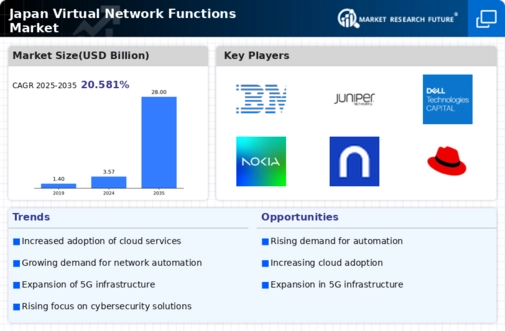Increased Focus on Cost Efficiency
Cost efficiency remains a pivotal concern for businesses in Japan, influencing the virtual network-functions market. Organizations are increasingly looking for ways to reduce operational costs while maintaining high service quality. Virtual network functions offer a compelling solution by minimizing the need for physical hardware and enabling more efficient resource utilization. This trend is particularly relevant in sectors such as telecommunications and IT services, where margins can be tight. Reports indicate that companies adopting virtualized solutions can achieve cost savings of up to 30%, making it an attractive proposition for businesses aiming to enhance their bottom line while investing in modern network capabilities.
Rising Demand for Network Flexibility
The virtual network-functions market in Japan experiences a notable surge in demand for network flexibility. Enterprises are increasingly seeking solutions that allow for rapid deployment and scalability of network services. This trend is driven by the need to adapt to changing business environments and customer requirements. According to recent data, the market is projected to grow at a CAGR of approximately 15% over the next five years. Companies are recognizing that traditional hardware-based solutions are often too rigid and costly, leading to a shift towards virtualized network functions. This shift not only enhances operational efficiency but also reduces capital expenditures, making it a compelling choice for businesses aiming to optimize their network infrastructure.
Growing Importance of Network Security
As cyber threats continue to evolve, the importance of network security in the virtual network-functions market cannot be overstated. Japanese enterprises are increasingly prioritizing security measures within their network architectures. The integration of security features into virtual network functions is becoming a standard practice, as organizations seek to protect sensitive data and maintain compliance with regulatory requirements. The market for security-focused virtual network functions is projected to grow significantly, with estimates suggesting a potential increase of 20% in demand over the next few years. This trend highlights the necessity for businesses to adopt comprehensive security strategies that align with their virtual networking solutions.
Shift Towards 5G Network Infrastructure
The ongoing shift towards 5G network infrastructure in Japan is a critical driver for the virtual network-functions market. As telecommunications companies invest heavily in 5G technology, the demand for virtualized network functions is expected to rise. This transition allows for enhanced data speeds and lower latency, which are essential for supporting a wide range of applications, from IoT to smart cities. Industry analysts suggest that the virtual network-functions market could see an increase in revenue by approximately $1 billion by 2027, driven by the need for agile and efficient network management solutions that 5G technology necessitates.
Government Initiatives Supporting Digital Transformation
In Japan, government initiatives aimed at promoting digital transformation significantly impact the virtual network-functions market. The government has launched various programs to encourage the adoption of advanced technologies, including virtualized networking solutions. These initiatives are designed to enhance the country's competitiveness in the global market. For instance, the Ministry of Internal Affairs and Communications has allocated substantial funding to support research and development in this area. As a result, the virtual network-functions market is expected to benefit from increased investments and a favorable regulatory environment, potentially leading to a market growth rate of around 12% in the coming years.



















Leave a Comment